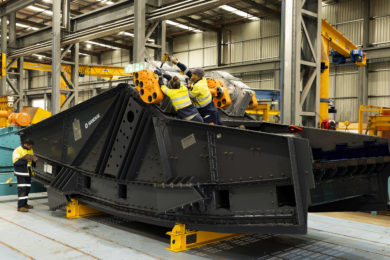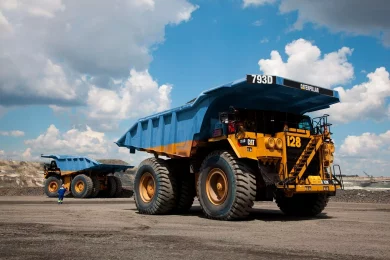 By Marc Davis, www.BNWnews.ca It’s just a matter of time before Western Potash is gobbled up by a potash-hungry major mining company, according to investment industry analysts who follow the global fertiliser industry. But the tiny Vancouver-based potash development company is in no hurry.
By Marc Davis, www.BNWnews.ca It’s just a matter of time before Western Potash is gobbled up by a potash-hungry major mining company, according to investment industry analysts who follow the global fertiliser industry. But the tiny Vancouver-based potash development company is in no hurry.
Company spokesperson John Costigan says Western Potash is still moving aggressively forward with its plans to become a potash producer at its Milestone deposit in potash-rich Saskatchewan. And management won’t consider any takeover offers until the marketplace assigns the company a valuation that is comparable or superior to Potash One.
Last month, Potash One accepted a buy-out offer valued at C$434 million or C$4.50 a share from the European fertiliser heavyweight K+S Group following the long-awaited publication of a full feasibility study on its Legacy deposit.
The pending Potash One takeover leaves Western Potash as the “last man standing,” according to Costigan. By which he means that it’s now the only one left of Saskatchewan’s tiny handful of potash explorers that has a firm grasp on the size and economic potential of its potash assets.
The only other potash junior in the region that also benefited from a resource estimate (which was still at the pre-feasibility stage) was Athabasca Potash. It was acquired by BHP Billiton last March in a deal worth C$341 million or C$8.35 a share.
Noting that Western Potash just announced a C$40 million equity financing last week (including a potential additional C$6 million over-allotment), an upbeat Costigan says his company will have plenty of cash-on-hand to control its destiny for the foreseeable future.
“It’s full steam ahead. If this latest financing is fully subscribed, and all of our warrants from this financing and past financings are exercised, that could top up our treasury to well over C$100 million,” he says.
Such a sizeable war-chest would be ample to complete both a prefeasibility study and a ‘make or break’ full-blown feasibility study, Costigan says. In the near-term, the C$40 million cash infusion, alone, will allow the company to immediately get the C$7 million prefeasibility study underway, with a six to seven month timeline to completion. A final feasibility study would involve a further approximately $43 million expenditure and would take another 12 months to finalise, Costigan adds.
Western Potash’s game plan is following a proven formula, according to Jaret Anderson, a fertilisers and agriculture investment analyst for the Vancouver-based investment bank Salman Partners. He notes that the same strategy of reaching such critical developmental benchmarks has worked out well for Saskatchewan’s other two advanced-stage potash juniors.
“Both Athabasca Potash and Potash One secured substantial bids from established mining/potash companies this year on the back of exploration and engineering work,” he says. “The development potash producer business model can yield significant returns to shareholders.”
Siddharth Rajeev, a mining analyst for the Vancouver-based investment research company, Fundamental Research, agrees that Western Potash should at least complete a prefeasibility study to generate a higher share price evaluation. “The company should be able to negotiate a better deal once this study is completed,” he says.
Western Potash is currently “very undervalued,” says Rajeev, especially since its story is “very comparable” to Potash One in that both the Legacy and Milestone deposits have similar production profiles and similar mine development and operating cost structures.
For instance, Potash One’s recently published feasibility study projects an annual output of 2.86 Mt of potash at the Legacy deposit at average operating costs of C$63/t over at least 40 years. Similarly, Western Potash’s preliminary economic assessment forecasts a yield of 2.5 Mt/y at the same average operating costs over a minimum of four decades.
That said, Potash One deserves a higher market capitalization, Rajeev says. That’s because its business model is considerably more advanced. Also, Legacy’s resource base is the larger of the two at 251 Mt, compared to Milestone’s 174 Mt.
The appeal of both projects is underscored by the fact that both Milestone and Legacy are amenable to ‘solution-extraction’ mining methods, Rajeev adds. This translates into much lower capital expenditures and operating costs than conventional potash mines.
Western Potash spokesperson Costigan says that the odds in favour of a lucrative potash mine being commissioned by 2015 at Milestone are also supported by its close proximity to the largest solution-extraction potash operation in the world, the Belle Plaine mine. Owned by the potash giant, The Mosaic Co, it has been in business for over 40 years and is still going strong at around 2.8 Mt/y of output.
Meanwhile, the most obvious fit for Western Potash might be Vale, according to Rajeev. Brazil-based Vale already has a strategic foothold in Saskatchewan where it is building its own a solution-extraction potash mine. Notably, Vale SA’s project borders the Milestone deposit. This is particularly encouraging for Western Potash, which believes that its own deposit exhibits similar geological features – ones that are also likely suitable for the realisation of an energy-efficient and therefore cost-efficient solution-extraction mine.
Anderson also wonders whether Vale may be inclined to expand its footprint among the world’s richest and most prolific potash fields by doing a deal with Western Potash. “Vale has made some comments recently about the intent to make significant investments in Canada,” he says. “Whenever you’ve got guys that are next door it always makes sense to see what the synergies would be for combining the two projects and running them as one. I think they should both consider that choice.”
“But the Milestone asset is an attractive asset to a great number of companies, including ones that are already in the potash sector,” he adds. “And there’s also BHP who are looking to get into Canada’s potash sector.”
Anderson also thinks it would make sense for the Chinese to lock-in future Canadian potash supplies, perhaps by way of a takeover of Western Potash. Or alternatively, the Chinese may yet propose an ‘off-take’ agreement, whereby they are guaranteed certain quantities of potash each year at a predetermined “reasonable” price in exchange for helping to finance mine construction costs at Milestone.
“The Chinese have an incentive to encourage the development of ‘greenfields’ (in-development) potash projects,” he adds. “So, co-operating with companies like Western Potash… makes a lot of sense for them.”
And now that Western Potash is the only advanced-stage junior developer left in Saskatchewan, Anderson says it also benefits from its “scarcity value” due to it now being “a unique asset that may attract interest from those seeking entry into the Saskatchewan potash industry.”
But Western Potash is being coy about who it may want to do business with. In a November 25 news release, the company said that it’s evaluating all options and is in discussions with takeover suitors, as well as aspiring merger or joint venture partners.
The principals of www.BNWnews.ca do not directly or indirectly own shares of any of the companies mentioned in this article.









